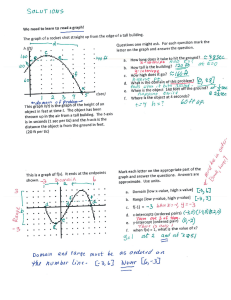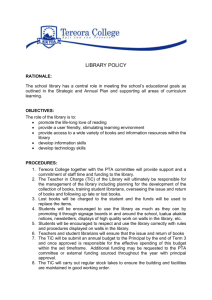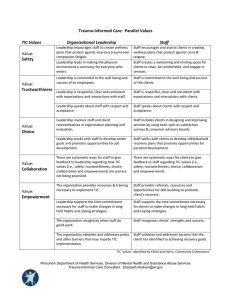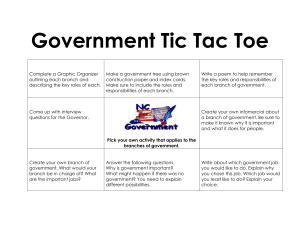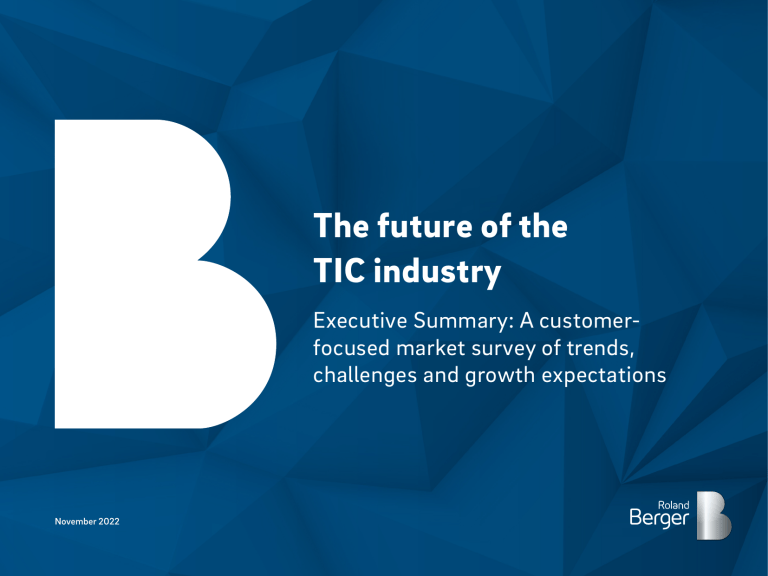
The future of the TIC industry Executive Summary: A customerfocused market survey of trends, challenges and growth expectations November 2022 2 The future of the TIC industry Roland Berger conducted a customer-focused market study to survey trends, challenges and opportunities in the TIC industry About the study For the first time, Roland Berger has conducted a customerfocused market study of the TIC-services market. Contrary to existing surveys, the study only includes responses from TIC-customers and excluded employees from TIC-companies. Study responses have been collected in Q1 2022. DESCRIPTIVE STATISTICS OF THE SURVEY PARTICIPANTS Functional field TIC purchase segment 1% Study approach and methodology: 1) Preparing the survey: Interviews and discussions with TIC market experts for setup of survey questionnaire (segmentation, question items, etc.) 2) Conducting the survey: Approach of RB contact network and further external agency contacts with survey questionnaire to collect responses from TIC customers 3) Interpreting the results: Interviews and discussions with TIC market experts to find interpretations and implications of the survey as well as to validate findings TIC purchase frequency 15% 32% 34% 14% 19% 17% 7% 12% 16% 28% 7% 12% 15% 43% 29% Management Automotive & Mobility Several times a month Operations Building & Construction Monthly Quality and product management Consumer Goods & Electronics Quarterly R&D Food & Agriculture Yearly Others Life Science & Healthcare Less than once a year Never Source: Roland Berger Roland Berger has extensive TIC-specific industry and project knowledge. We would welcome discussion of the implications of this study and look forward to your perspective on ongoing challenges. Please don't hesitate to contact us and get in touch. 3 The future of the TIC industry Management Summary TIC market growth and trends • In general, the global testing, inspection and certification (TIC) market continues its historically positive growth outlook, particularly in Asia Pacific and Europe. However, expected growth rates are yet to keep up with inflation rates. • The historical market trend of TIC growth of ~3% above GDP growth is expected to continue with slight differences between the regions. • Most European TIC players showed moderate revenue growth rates up to 4% from 2016 to 2021; German companies recorded healthy revenue growth but lower profitability compared to international competitors. • Eight key trends are set to impact the TIC industry: - Supply-chain liability - Penetration of digitalization - Sustainability, ESG & climate change - Technological progress - Regulation - Change in market structures - Demographic changes - Population growth Survey results and areas for action • This survey includes five major TIC market segments (Automotive & mobility, Building & construction, Consumer goods & electronics, Food & agriculture, Life science & healthcare) and identifies the needs of TIC customers and required actions in the light of future challenges. • Growth expectations are mostly positive. However, compared to other segments, the Automotive & mobility and Consumer goods & electronics segments have reduced growth outlooks. • The key trends viewed by respondents as driving demand were sustainability (10-26%), regulation (6-22%) and technological progress (0-19%). • The most relevant service offerings varied (e.g., vehicle type approval in Automotive & mobility, food testing in Food & agriculture) due to the heterogeneous nature of TIC service segments. • When choosing TIC providers, respondents tended to focus on price, service quality and value-added services. Reputation was not a decisive factor. • Across all segments, regulation was the main driver for demand growth, followed by sustainability. Outsourcing and quality improvements were often secondary. 4 The future of the TIC industry Growth in the TIC market: Global TIC revenues grew by ~3% above GDP growth from 2016 to 2021 – Europe as second-largest market The global TIC (quality assurance) industry is growing strongly. Its market volume is forecasted to rise from EUR 158 billion in 2020 to EUR 192 billion in 2024, with growth rates of up to 12.5% in the same period. Asia Pacific is the largest TIC market, with rapid industrialization in the infrastructure, energy and transport sectors (especially in China and India) generating considerable opportunities for TIC services. In Europe, the second-largest market, growth is driven mainly by the surge in trade of counterfeit and pirated goods, as well as a trend towards outsourcing services. Growing demand for imported products is driving testing/inspections in North America. Overall growth predictions for the TIC market are in line with past performance. An industry rule of thumb is that TIC market growth is around 3% above GDP growth. Recent data suggests that this overall trend will continue in the next few years, especially in Asia Pacific and Europe. The growth rate in North America has historically been an outlier and less consistent. Focus on Europe Most European TIC players experienced growth of 0-4% between 2016 and 2021, recovering quickly from the COVID-related dip in 2020. Eurofins, headquartered in Luxembourg, stood out with extraordinary revenue growth. This was driven by extensive M&A activity and COVID testing. Its EBIT margin also soared, reaching 19% in 2021. While keeping up with most competitors in terms of revenue growth, German players were less profitable (see next page). ROWING UP: THE ASIA-PACIFIC MARKET IS DRIVING GLOBAL TIC REVENUE GROWTH Global TIC market volume by region, 2016-2024 [EUR bn] CAGR CAGR 2016-2020 2020-2024 7.6% 192 181 169 158 5.6% 145 137 126 115 3 2 17 3 2 5 2 4 2 4 2 20 19 4 2 143 4 2 6 2 5.1% 12.5% 1.7% 4.7% North America 3.6% 5.5% 69 Europe 3.8% 6.1% 91 Asia Pacific 8.1% 9.2% 6 2 South America MEA 24 23 22 21 19 65 18 62 58 54 56 54 50 47 53 47 2016 2017 58 2018 63 2019 64 2020 78 72 2021 2022 Source: Euromonitor; Markets and Markets; Mordor Intelligence; Roland Berger 85 2023 2024 5 The future of the TIC industry While keeping up with most international TIC competitors in terms of revenue growth, German players have been less profitable in the past REVENUE GROWTH AND PROFITABILITY OF SELECTED EUROPEAN TIC PLAYERS 22% 20% Intertek 18% 16% Eurofins 14% EBIT margin 2021 SGS 12% DNV GL 10% Bureau Veritas Ø 11% 8% 6% TÜV Süd TÜV Rheinland 4% Applus+ TÜV Nord Dekra 2% 0% 0% 1% 2% 3% 4% Revenue CAGR 2016-2021 Size of circled area represents relative revenue size in 2021 Source: Company information 5% 20% 21% 22% 6 The future of the TIC industry Challenges and actions: Several trends/challenges are impacting TIC players – We conducted a customer-focused market survey to find out how to address them Despite the growth achieved in the past few years, TIC players face significant long-term challenges in addition to short-term profitability issues. Roland Berger has identified eight mega trends that are already impacting or will impact the industry (see graphic below). What TIC players need to do To gain a better understanding of the challenges facing TIC providers, Roland Berger conducted a survey focusing on the five key demand-side TIC segments: Automotive & mobility; Building & construction; Consumer goods & electronics; Food & agriculture; and Life science & healthcare. This helped to determine what customers want and what TIC players need to do. Questions focused on four key areas: Growth expectations; Trends impacting growth; Most relevant service offerings (what type of TIC-services customers demand); and most important purchasing criteria (what providers need to offer). Responses in each key area are summarized by industry segment over the following pages, along with a summary of the outlook and key results/implications. Survey participants were B2B TIC service customers from a broad spectrum of industries (for example, retail, automotive, consumer goods). They ranged from small players with revenues of less than EUR 500 million to global players with revenues above EUR 10 billion. Most purchased TIC services either quarterly or yearly. KEY MEGA TRENDS TIC players need to prepare for the challenges of digitalization, sustainability and market changes 1 Supply-chain liability 2 Penetration of digitalization1 3 Sustainability, ESG & climate change1 • Increasing complexity through fully interconnected supply chains • Increasing relevance of B2C and B2B digitalization (e.g., IOT, data analytics) • Need for significant greenhouse-gas reductions (CO2, methane, etc.) • Necessity of supplychain control and compliance foster de-globalization • Rising threat of cyberattacks • Decarbonization of entire business models • Continued digitalization of TIC processes 4 •E volution of new and more advanced products and services that require TIC services •S hortening of technological lifecycles between innovations Rather short-term 1 Trends interlinked and potentially dependent on respective local, national and international regulation Source: Roland Berger Technological progress1 5 Regulation • Increasing regulatory requirements regarding a product's or service's quality, sustainability or safety TIMING OF TRENDS 6 Change in market structures • Ongoing market consolidation within the entire TIC industry 7 Demographic changes • Increasing global urbanization • Emerging economies • Trend towards with large youth privatization of TIC population and rather than ownership/ booming birth rates contracting by public • Aging population in authorities industrialized countries 8 Population growth • Increasing global population • Significant overpopulation of Asian and African countries • Emerging middle class, especially in emerging markets Rather long-term 7 The future of the TIC industry Survey summary: Most market segments have a positive outlook for growth in TIC service demand, however noticeable differences between market segments EXECUTIVE OVERVIEW OF RESULTS BY TIC MARKET SEGMENT Outlook AUTOMOTIVE & MOBILITY BUILDING & CONSTRUCTION CONSUMER GOODS & ELECTRONICS FOOD & AGRICULTURE LIFE SCIENCE & HEALTHCARE • Neutral growth outlook: Only 46% of respondents expect increasing demand for TIC services • Very positive growth outlook (84%) for TIC service demand •R educed growth outlook: Only 35% of respondentsexpect increasing demand for TIC services •P ositive outlook: 63% of respondents expect overall increase in demand for TIC services • Very positive outlook for overall service segment (83%) • Quality improvements are main driver for demand growth • Food regulations expected to be main growth drivers for TIC service demand •M ost relevant services require digital and technological capabilities from TIC service provider: • " Food testing and certification" as well as "Food microbiology testing" most relevant TIC services • Quality improvements as growth driver – regulation and outsourcing less important Key results • Regulation seen as clear driver for growth: new trends (e.g., sustainability) are pushed through regulation into the market • „Vehicle type approval“ and „statutory vehicle inspection“ continue to be most demanded TIC services” • "Materials testing and certification" as well as general "Fire testing" services most relevant TIC offerings • Emergence of new technologies (especially e-mobility) has direct impact on relevant services and leads to overall reduced growth expectation • Further growth driven especially by regulatory and sustainability trends: Industry demand driven by regulatory specifications concerning sustainability and safety requirements Source: Roland Berger – "Connectivity and electronic device testing" – "Microelectronics quality control" • Food-related TIC service growth driven mostly by growing population and sustainability mega trends • Heavily regulated industry: Regulation is expected to continue to be maindriver for TIC service demand • TIC services for medical devices gaining relevance: "Biocompatibility" and "Materials testing for medical devices" top two most relevant TIC services • Growth driven mostly by regulation, as well as technological progress 8 The future of the TIC industry Automotive & mobility industry: Neutral overall growth expectations, largely due to the lower testing requirements of new technologies NOTABLE/OTHER RESULTS Purchasing criteria: Reputation is not decisive when purchasing B2B TIC services. However, reputation may be relevant for B2C and marketing efforts that have not been surveyed. Clear B2B focus on service quality, value-added services and pricing Drivers: Quality improvements the main driver for utilizing more quality assurance services (59% of respondents). Regulation (23%) less important – new engine types will need fewer type approvals and inspections How do you assess the overall growth perspective for quality assurance services within the next three years? DECLINE Which overall market trends do you expect to most positively impact growth of quality assurance service demand? GROWTH 50% 1. Penetration of digitalization 21% 2. Sustainability & climate change 46% 19% 3. Technological progress 16% 15% 4. Change in market structures 10% 5. Supply chain liability 4% Decline Constant 6. Population growth 9% 7. Regulation 9% 1% 8. Demographic changes Growth In your view, what will be the five most relevant quality assurance service offerings for your company? In your view, what are the most important purchase criteria forquality assurance services? IMPORTANCE 1. Vehicle type approval 46% 2. Statutory vehicle inspection 23% 3. Aerospace testing, certification and inspection services 15% Price Speed Reputation 4. Performance claim & support 8% Service quality 5. Road & rail services 8% Value added/supporting services 0% Source: Roland Berger 25% 50% 75% 100% 9 The future of the TIC industry Building & construction: A very positive overall growth outlook driven by rising regulation, especially around sustainability requirements NOTABLE/OTHER RESULTS Purchasing criteria: Quality and price are key criteria. Reputation not decisive, due to focus on B2B services. Value-added services a major growth area Drivers: All respondents see regulation as main driver – new construction/ renovation projects highly influenced by regulations. Other relevant trends, especially sustainability measures, pushed through regulatory requirements How do you assess the overall growth perspective for quality assurance services within the next three years? DECLINE Which overall market trends do you expect to most positively impact growth of quality assurance service demand? GROWTH 26% 1. Sustainability & climate change 84% 22% 2. Regulation 12% 3. Population growth 16% 10% 5. Supply chain liability 10% 6. Technological progress 10% 6% 7. Change in market structures 0% Decline 4. Demographic changes Constant 4% 8. Penetration of digitalization Growth In your view, what will be the five most relevant quality assurance service offerings for your company? In your view, what are the most important purchase criteria forquality assurance services? IMPORTANCE 1. Materials testing 21% Price 2. Materials certification 16% Speed 3. Fire testing 16% Reputation 11% 4. Plant safety & integrity services 5. Analysis of impurities & contaminants 5% Service quality Value added/supporting services 0% Source: Roland Berger 25% 50% 75% 100% 10 The future of the TIC industry Consumer goods & electronics: Reduced overall growth expectation, with almost two thirds of respondents predicting stagnation NOTABLE/OTHER RESULTS Service offerings: Electronics and digitalization services most relevant as clear connection to technological trends within the segment. Few growth impulses from regulation as most regulations already implemented Drivers: Almost half (45%) of respondents name quality improvements as main growth driver, outsourcing and regulation both at 28%. Segment has heterogeneous TIC needs How do you assess the overall growth perspective for quality assurance services within the next three years? DECLINE Which overall market trends do you expect to most positively impact growth of quality assurance service demand? GROWTH 1. Penetration of digitalization 63% 20% 2. Sustainability & climate change 18% 3. Technological progress 13% 11% 4. Supply chain liability 35% 11% 5. Change in market structures 3% Decline Constant 6. Population growth 10% 7. Regulation 10% 7% 8. Demographic changes Growth In your view, what will be the five most relevant quality assurance service offerings for your company? In your view, what are the most important purchase criteria forquality assurance services? IMPORTANCE 1. Connectivity testing (Internet, Bluetooth, mobile, etc.) 38% 2. Electronic device testing 24% 19% 3. Microelectronics quality control Price Speed Reputation 4. Chemical testing 10% Service quality 5. Product Conformity Assessment (PCA) 10% Value added/supporting services 0% Source: Roland Berger 25% 50% 75% 100% 11 The future of the TIC industry Food & agriculture: Tighter regulation and rising interest in sustainability as well as meat alternatives leads to increased growth expectations NOTABLE/OTHER RESULTS Positive trends: Population growth the key trend, especially in Asian markets. Demographic changes impact population growth in all markets, including those in the West. Trend towards sustainable food also important Drivers: Regulation the main driver with 63% of regulation the main driver with 63% of respondents considering it relevant – quality improvements only secondary (38%). Regulation impacts segment through taxation (e.g., sugar taxes) and sustainability targets How do you assess the overall growth perspective for quality assurance services within the next three years? DECLINE Which overall market trends do you expect to most positively impact growth of quality assurance service demand? GROWTH 1. Population growth 63% 26% 2. Sustainability & climate change 23% 3. Supply chain liability 37% 14% 4. Change in market structures 11% 5. Demographic changes 11% 6. Penetration of digitalization 9% 7. Regulation 0% Decline Constant 6% 0% 8. Technological progress Growth In your view, what will be the five most relevant quality assurance service offerings for your company? In your view, what are the most important purchase criteria forquality assurance services? IMPORTANCE 1. Food testing and certification 75% 2. Food microbiology testing 25% Price Speed 3. Crop & forest services 0% Reputation 4. Crop monitoring & agronomic services 0% Service quality 5. Food contaminant testing 0% Value added/supporting services 0% Source: Roland Berger 25% 50% 75% 100% 12 The future of the TIC industry Life science & healthcare: A positive outlook as regulation and technological developments continue to drive growth – COVID has pushed awareness for medical TIC services NOTABLE/OTHER RESULTS Positive trends: While regulation top due to "safety first" nature of segment, technological progress and change in market structures also key trends due to digitalization and evolution of services. Rising complexity of medtech products, in particular, will increase technological requirements for offered TIC services Drivers: A majority of respondents see regulation as the main driver for utilizing more TIC services, with 44% naming quality improvements How do you assess the overall growth perspective for quality assurance services within the next three years? DECLINE Which overall market trends do you expect to most positively impact growth of quality assurance service demand? GROWTH 22% 1. Regulation 83% 2. Technological progress 19% 3. Change in market structures 17% 0% Decline Constant 12% 4. Supply chain liability 10% 5. Sustainability & climate change 10% 6. Population growth 10% 7. Penetration of digitalization 10% 8. Demographic changes Growth In your view, what will be the five most relevant quality assurance service offerings for your company? 7% In your view, what are the most important purchase criteria forquality assurance services? IMPORTANCE 1. Biocompatibility testing for medical devices 16% Price 2. Materials testing for medical devices 16% Speed 3. Clinical trial management (Phase I-IV) 11% Reputation 4. Early phase clinical research services 11% Service quality 5. Electrical & electro medical device testing 11% Value added/supporting services 0% Source: Roland Berger 25% 50% 75% 100% PUBLISHER Authors Benedikt Rickmers Senior Partner +49 160 744-8006 benedikt.rickmers@rolandberger.com Markus Strietzel Senior Partner +49 160 744-2244 markus.strietzel@rolandberger.com Niko Herborg Partner +49 160 744-6131 niko.herborg@rolandberger.com Tobias Hanspach Senior Project Manager +49 160 744-6159 tobias.hanspach@rolandberger.com ROLAND BERGER GMBH Sederanger 1 80538 Munich Germany +49 89 9230-0 www.rolandberger.com Roland Berger has extensive TIC-specific knowledge and we would welcome discussion of the implications of this study. Please don't hesitate to contact us. Cover iZonda/Getty Images About us ROLAND BERGER is the only management consultancy of European heritage with a strong international footprint. As an independent firm, solely owned by our Partners, we operate 51 offices in all major markets. Our 2700 employees offer a unique combination of an analytical approach and an empathic attitude. Driven by our values of entrepreneurship, excellence and empathy, we at Roland Berger are convinced that the world needs a new sustainable paradigm that takes the entire value cycle into account. Working in cross-competence teams across all relevant industries and business functions, we provide the best expertise to meet the profound challenges of today and tomorrow. We welcome your questions, comments and suggestions WWW.ROLANDBERGER.COM This publication has been prepared for general guidance only. The reader should not act according to any information provided in this publication without receiving specific professional advice. Roland Berger GmbH shall not be liable for any damages resulting from any use of the information contained in the publication. © 2022 ROLAND BERGER GMBH. ALL RIGHTS RESERVED.
